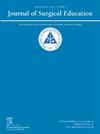Impact of Preoperative Warm-Up on Surgical Performance of Resident Physicians: A Randomized Controlled Trial
IF 2.6
3区 医学
Q1 EDUCATION, SCIENTIFIC DISCIPLINES
引用次数: 0
Abstract
Introduction
Surgical learning is a complex process that involves resident characteristics, instructional methods, and technological tools. As surgical residency programs become more diverse, there is a growing need for adaptable training methods that align with various learning styles and backgrounds. Manual dexterity and self-assessment skills are essential for residents, and recent studies highlight those residents with refined manual skills perform better in surgery. Preoperative warm-up is emerging as a potential strategy to improve immediate surgical performance. The study aimed to analyze whether preoperative warm-up in low-cost surgical simulators (training boxes) is related to an immediate improvement in the intraoperative performance of general surgery residents inexperienced in laparoscopy.
Methods
The study used a swine model for surgical simulations in a controlled training environment. 105 first-year general surgery residents were divided into 2 groups: the control group (performed procedures without warm-up) and the intervention group (performed a 10-minute preoperative warm-up using a training box).
Results
The Intervention group demonstrated improved efficiency in cholecystectomy (2.97 ± 0.4 vs 2.41 ± 0.91, p = 0.03), with reductions of 41.5% in cholecystectomy dissection time (4.82 ± 4.94 vs 8.23 ± 5.15 minutes, p = 0.02) and 15.6% in left radical nephrectomy dissection time (13.03 ± 4.49 vs 16.77 ± 3.90 minutes, p = 0.012).
Conclusions
Preoperative warm-up using a training box significantly improved the qualitative and quantitative surgical performance of general surgery residents with no prior laparoscopic experience, particularly by increasing efficiency in cholecystectomy and reducing dissection times in both cholecystectomy and left radical nephrectomy.
求助全文
约1分钟内获得全文
求助全文
来源期刊

Journal of Surgical Education
EDUCATION, SCIENTIFIC DISCIPLINES-SURGERY
CiteScore
5.60
自引率
10.30%
发文量
261
审稿时长
48 days
期刊介绍:
The Journal of Surgical Education (JSE) is dedicated to advancing the field of surgical education through original research. The journal publishes research articles in all surgical disciplines on topics relative to the education of surgical students, residents, and fellows, as well as practicing surgeons. Our readers look to JSE for timely, innovative research findings from the international surgical education community. As the official journal of the Association of Program Directors in Surgery (APDS), JSE publishes the proceedings of the annual APDS meeting held during Surgery Education Week.
 求助内容:
求助内容: 应助结果提醒方式:
应助结果提醒方式:


